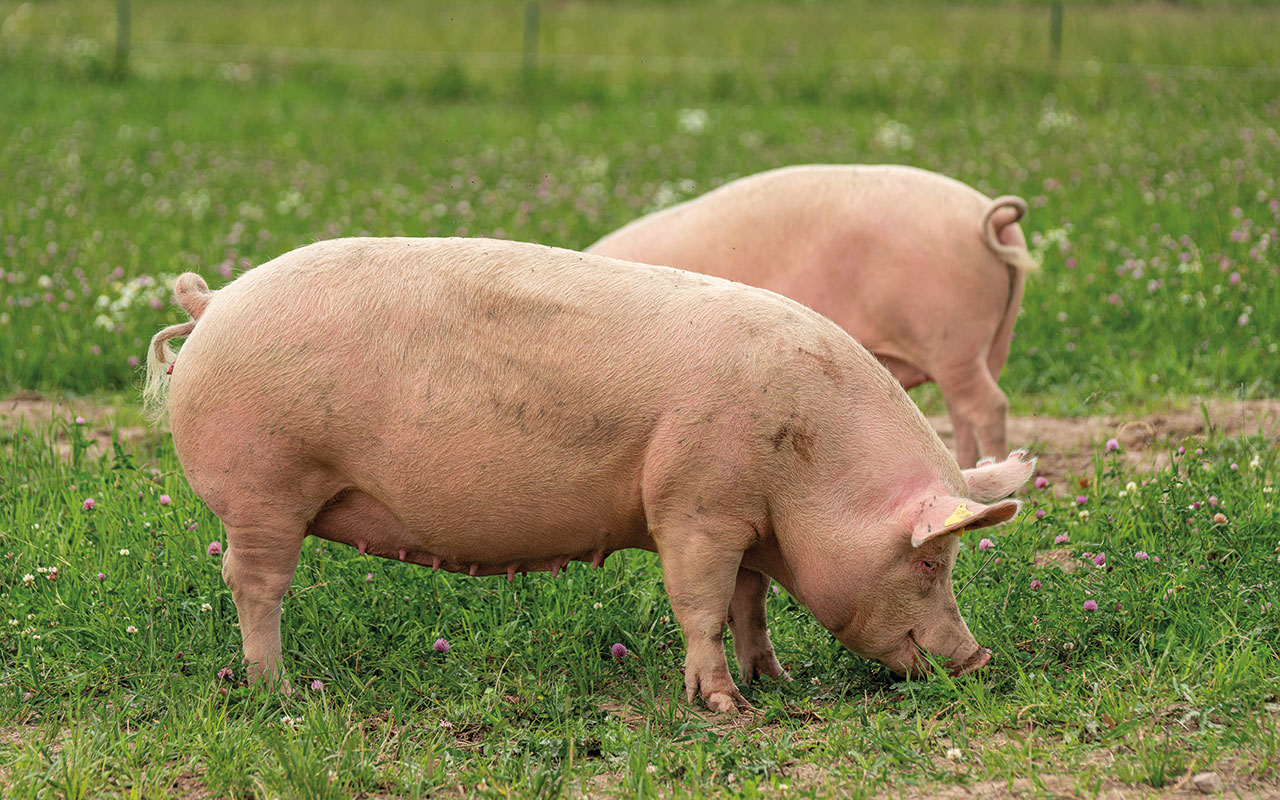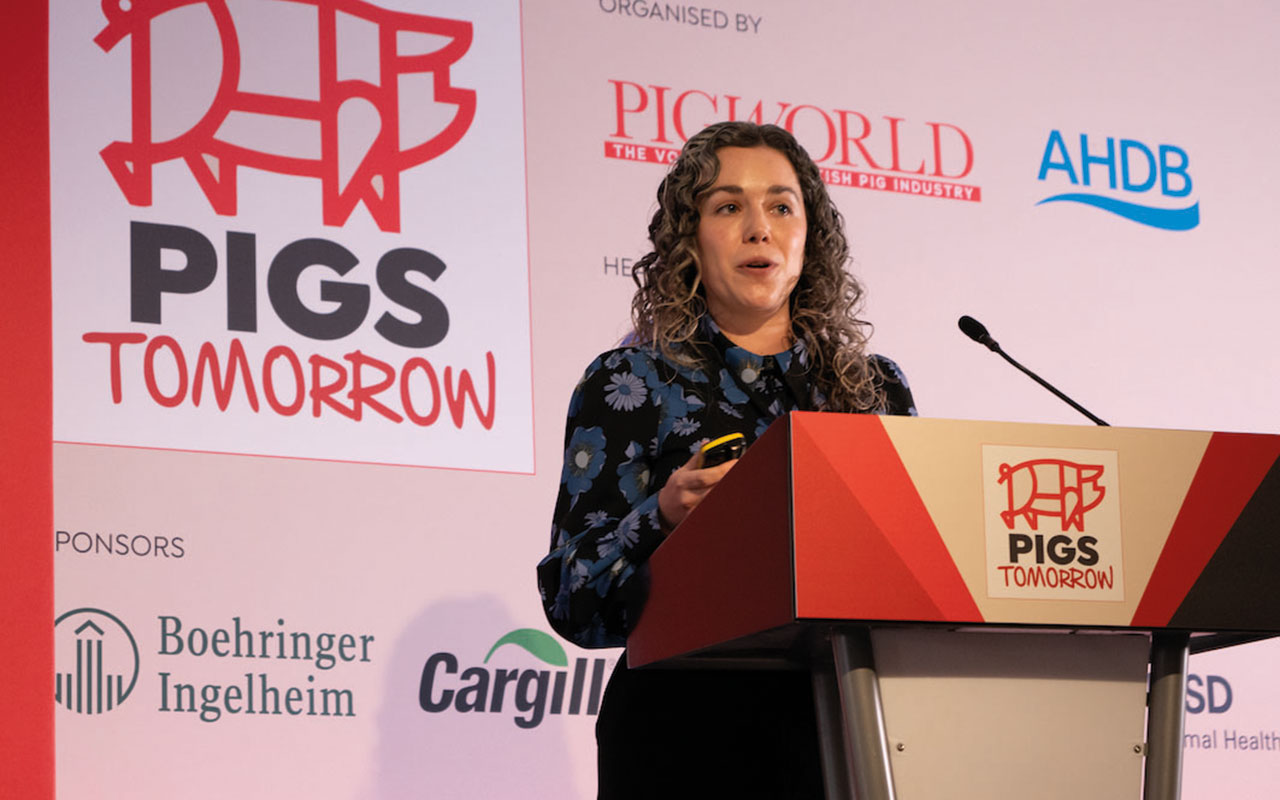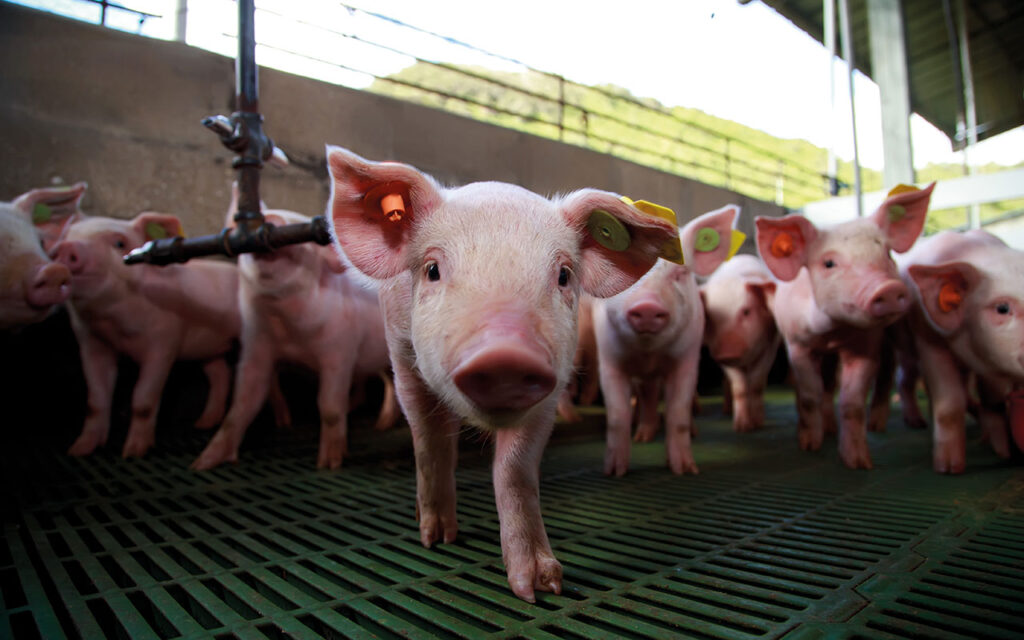
Unique research showing it is possible to perform relatively well on both pig welfare and the environment at the same time is providing vital science-based insights into these complex areas.
Presenting her findings at the Pigs Tomorrow conference in May, Dr Harriet Bartlett, research fellow at the University of Oxford, explained that her aim was to investigate the common belief that in pig farming – and farming, more broadly – improving one part of sustainability inevitably compromises other aspects of it. The conclusion was that trade-offs and compromises are not, in fact, inevitable.
Her work rigorously measured the impact of a broad range of pig production systems in four key areas that are important to us, both as pig producers and consumers – land use, greenhouse gas (GHG) emissions, antimicrobial use (AMU) and welfare outcomes.
When we spoke, Dr Bartlett also stressed the need for pig producers to have more clarity and standardisation around the tools used to measure and calculate their impacts.
The research highlights potential risks of measuring welfare and labelling pork products based on practices, such as the type of production system, rather than outcomes. Dr Bartlett said there was an important discussion to be had about method-of-production labelling, with the results of a government consultation on the topic currently under consideration.
Key findings
The study involved more than 150 pig farmers in the UK and Brazil, including 74 UK breed-to-finish systems, under different labels: Red Tractor, RSPCA Assured, free-range, organic and woodland farms, as well as those with no label.
Aspects of Brazilian production systems, including the large scale of its pig herds and the use of gestation crates and growth promoters, still permitted there, meant the farms used in the research broadly represented the range of commercial pig production systems found across the world.
The research found some positive associations, or ‘win-wins’, showing that farms where land use footprints were smaller also typically scored better for GHG emissions, which were lower. Where the data showed welfare was better, AMU was also lower.
The research found there were also trade-offs, with most of the farms that scored better for GHG emissions and land use scoring worse for welfare and AMU, and vice versa.
“Interestingly, the data also identified several farms with optimal systems – ‘bright spots’ – achieving good results for all four impact areas, showing that trade-offs are not inevitable and there is potential for farms to optimise their system for the planet and pigs,” Dr Bartlett explained.
“The ‘bright spots’ existed in different categories, including Red Tractor, RSPCA Assured and woodland farms, with no particular farm type predicting optimal systems.”
The study, unfortunately, did not find factors unique to these optimal farms, but future research is looking to identify what drives optimal performance and how farmers can achieve this.
It was established, however, that a good feed conversion ratio is needed for a farm to be in the top-performing 50% for reduced carbon emissions, for example. Whether or not factors such as attention to detail or management, which were suggested by audience members at the conference, had an influence would need more research.

Welfare and labelling
Dr Bartlett’s results show that, overall, good welfare scores do tend to align with methods of production as categorised by current assurance schemes, while land use and GHG footprints are the reverse, with fully indoor, slatted systems typically rating better on GHG emissions and land use.
However, she said current labelling on pork products, largely based on practices, are not always good indicators of impacts, which becomes evident when system outcomes for both pigs and the environment are investigated thoroughly.
“My worry with any form of method-of-production labelling is that there is potential variation in impact within a method, not just between methods, which wouldn’t be taken into account,” she said.
Therefore, work to improve pork product labelling to inform consumers is important, although it can take a lot of time and effort to influence consumer behaviour through food labelling.
There are also others to consider in the supply chain who are very influential, such as processors, retail buyers and agricultural managers, Dr Bartlett pointed out, who will increasingly be interested in benchmarking initiatives on farms, focusing on one or more of the key farming impacts.
On-farm value
She suggests the findings and methodologies from her research could be most useful in driving actual improvements on farm.
“We need to ask ourselves: what is the purpose of on-farm measurements? Is it to show consumers what farmers are already doing, or to give farmers better information to help them improve?
“Both are important, but what matters most is that the measurements are meaningful and help achieve our goals as farmers and as a society. By moving towards outcomes-based measurement, we can better understand how the changes we make on farm are really benefiting people, animals and the planet,” she said.
Welfare or environmental outcomes data can be added to existing performance data and used to better inform decision-making and boost the continual improvement that already happens on farms. The value to farmers is to help them adapt and keep farming in a sustainable way, environmentally and financially, with pig welfare and performance at the forefront.
Following her presentation, producers showed a lot of interest and optimism in the findings, Dr Bartlett said.
“They said it feels fairer to be measured based on outcomes rather than method of production. Outcomes are also easier to change than a farm’s whole method of production, and are what really matters to the planet and pigs,” she said.
Pilgrim’s progresses research
In follow-up, Dr Bartlett and the team at the University of Oxford are now working with Pilgrim’s Europe on a new project which aims to help pig farmers measure and manage their environmental outcomes.
“We are working with pig farmers to build a toolkit that works for them,” Dr Bartlett explained. “The toolkit will include bespoke information on each farm’s environmental outcomes, benchmarking against their peers, and specific actions they could take to improve.”
The scope of the project goes beyond greenhouse gas emissions and will include a wide range of life cycle assessment indicators, such as eutrophication, land use, water use and biodiversity and is part of a broader Farm Sustainability Toolkit Project run by HESTIA, a research programme at the University of Oxford.
Fabio Brancher, agriculture director at Pilgrim’s Europe, said: “We’re pleased to be partnering with Dr Bartlett and the University of Oxford team on this groundbreaking environmental research project. At Pilgrim’s Europe, we recognise that sustainable pig farming requires data-driven solutions that work practically for our farmers on the ground.
“This innovative toolkit gives our producers concrete, farm-specific insights into their environmental performance alongside actionable steps for improvement. The comprehensive scope, covering everything from carbon emissions to biodiversity impacts, aligns perfectly with our commitment to sustainable agriculture.
“Beyond carbon footprinting, we believe farmers need tools that address the full spectrum of environmental outcomes. This research will help our network of producers benchmark their performance and identify the most effective pathways to enhance their farm’s sustainability profile, while maintaining productivity.”
Improving measurements
In-depth welfare outcomes measurement systems are well-established and widely used, and AMU is now comprehensively measured farm by farm on the electronic medicine book, eMB Pigs.
A key priority now is to bring the way we measure the other crucial areas we care about – for example, biodiversity and climate – up to the same level as welfare outcomes, Dr Bartlett suggested.
There is always a balance in terms of what is possible with the time and resource available for assessments. Dr Bartlett’s research measured welfare outcomes using the Welfare Quality system, which includes assessment of 30 different measures on farm, including lameness scoring and positive and negative behaviours. She said that level of rigour was vital for her research, including a requirement for her to pass the Welfare Quality training course before using it.
Assessments of pigs took several hours to complete on each farm, so this is not necessarily a scalable method for routine use on farm. UK assurance schemes currently assess a relatively small number of measures, typically between five and 10 that can be regularly collected within a realistic timeframe.
However, the certification Welfair, used in seven countries across the world, shows it is possible to carry out detailed welfare assessments at scale, with more than 14,000 Welfare Quality audits taking place in 2024 in Spain, representing 21% of Spanish pigs.
Another interesting aspect of Dr Bartlett’s work was the inclusion of quantity as well as quality in the welfare measurements, looking at ‘quality of life years’.
Some consumers might feel that animals should live for longer as part of good welfare, but it is more complex than that. If there are two farms with similar, relatively poor quality-of-life scores, but one has a lot more animals experiencing that and/or experiencing it for a longer period of time, that should potentially be taken into account.
A longer life does not necessarily mean better welfare in that case, whereas if an animal has a sufficiently high quality of life and also lives longer – for example, in a woodland assured system – that would lead to increasingly positive welfare scores.
Environmental tools
The desire for standardisation and comparable carbon footprinting tools was a clear message from producers at the Pigs Tomorrow conference, as was a preference for direct measurement on farm, rather than a modelling tool.
“Producers would like to have a piece of equipment on farm to measure environmental impacts – however, the challenges with that are that equipment is expensive and there are lots of variables across time and space on a farm that need to be taken into account,” explained Dr Bartlett. “Also, a major contributor to pig farming emissions is feed, which is off farm.”
Development of carbon-measurement models is moving quite fast, with many different organisations involved, and farmers are in need of consistent guidance. “There is a range of tools available, covering not just carbon emissions but also land use and biodiversity, for example,” she said.
The most important thing is that farmers get on and make a start and use the most suitable impact calculation tools currently available to help them improve, in some cases, on the basis that ‘perfect is the enemy of good’, Dr Bartlett added.
A priority for industry and Defra is to make the information about environmental outcomes more accessible to farmers and to have greater standardisation. On-farm monitoring also needs to be aligned to supply chain needs.
“The models for carbon footprint calculation are improving all the time and are already good enough to provide useful measurements. The challenge is that the calculations are not carried out consistently across the industry. There are, however, researchers working hard to find ways of standardising models and tools transparently, at the University of Oxford and elsewhere,” she said.
For her research, Dr Bartlett designed her own carbon calculator using the methods set out by the Intergovernmental Panel on Climate Change.
At the time, there were no freely available tools that could handle the complexity of many pig farms. Her calculator goes further than standard models, adding detail such as breaking manure management into separate stages – like storage – and incorporating feed formulations, so the impacts can be measured more accurately.
Impact of feed
The project enabled Dr Bartlett to develop methods of collecting more accurate and comparable data across pig production systems. For example, calculations for the area of land needed for production of one kilogram deadweight of pork included both the area of land the pigs were on and, importantly, the land used to produce the feed.
“I was able to get hold of all the different feed formulations for each farm and each stage of production, which made the study unique and more accurate than previous studies,” said Dr Bartlett. “Also, where possible, I included the country of origin of the feed ingredients, which can have a considerable effect on GHG emissions and land use.”
As well as emissions from feed, GHG calculations for pig production include emissions from the pigs themselves, transport, electricity and energy, slaughter and processing and foregone sequestration of carbon and opportunity cost.
The amount of enteric methane emitted from the pigs’ digestive system is very small. Meanwhile, nitrous oxide and methane from manure is calculated from values based on the energy values and nutrient contents in the feed pigs are eating, and their weight gain.
“By knowing the feed ration components for each stage of pig production, we could calculate methane and nitrous oxide emissions from manure much more accurately. This allowed us to estimate the nitrogen content of the feed precisely, and work out how much nitrogen was stored in the manure and how much was released into the atmosphere.”
Calculations also took into account that using manure on crops displaced the need for manufactured fertiliser. This overlaps with the fertiliser used on crops grown to produce pig feed, so Dr Bartlett circularised the system in the model to avoid any double counting.




